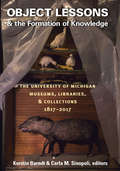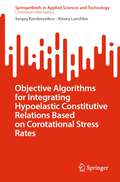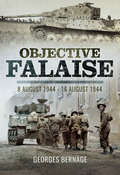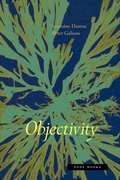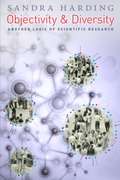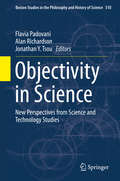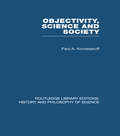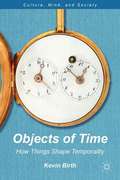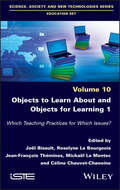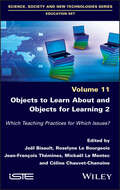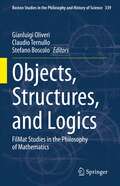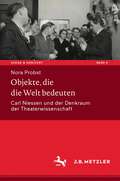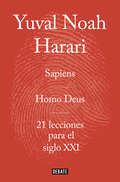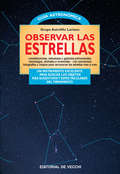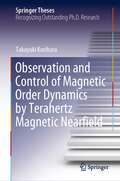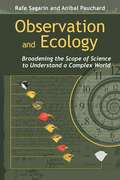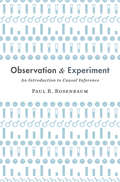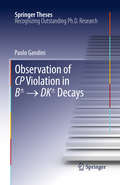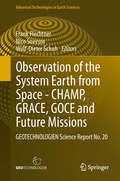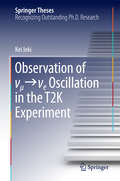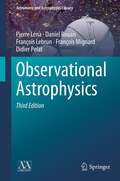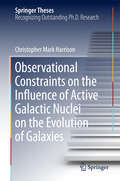- Table View
- List View
Object Lessons and the Formation of Knowledge: The University of Michigan Museums, Libraries, and Collections 1817–2017
by Kerstin Barndt Carla M SinopoliObject Lessons and the Formation of Knowledge explores the museums, libraries, and special collections of the University of Michigan on its bicentennial. Since its inception, U-M has collected and preserved objects: biological and geological specimens; ethnographic and archaeological artifacts; photographs and artistic works; encyclopedia, textbooks, rare books, and documents; and many other items. These vast collections and libraries testify to an ambitious vision of the research university as a place where knowledge is accumulated, shared, and disseminated through teaching, exhibition, and publication. Today, two hundred years after the university’s founding, museums, libraries, and archives continue to be an important part of U-M, which maintains more than twenty distinct museums, libraries, and collections. Viewed from a historic perspective, they provide a window through which we can explore the transformation of the academy, its public role, and the development of scholarly disciplines over the last two centuries. Even as they speak to important facets of Michigan’s history, many of these collections also remain essential to academic research, knowledge production, and object-based pedagogy. Moreover, the university’s exhibitions and displays attract hundreds of thousands of visitors per year from the campus, regional, and global communities. Beautifully illustrated with color photographs of these world-renowned collections, this book will appeal to readers interested in the history of museums and collections, the formation of academic disciplines, and of course the University of Michigan.
Objecting to God
by Colin HowsonThe growth of science and a correspondingly scientific way of looking at evidence have for the last three centuries slowly been gaining ground over religious explanations of the cosmos and mankind's place in it. However, not only is secularism now under renewed attack from religious fundamentalism, but it has also been widely claimed that the scientific evidence itself points strongly to a universe deliberately fine-tuned for life to evolve in it. In addition, certain aspects of human life, like consciousness and the ability to recognise the existence of universal moral standards, seem completely resistant to evolutionary explanation. In this book Colin Howson analyses in detail the evidence which is claimed to support belief in God's existence and argues that the claim is not well-founded. Moreover, there is very compelling evidence that an all-powerful, all-knowing God not only does not exist but cannot exist, a conclusion both surprising and provocative.
Objective Algorithms for Integrating Hypoelastic Constitutive Relations Based on Corotational Stress Rates (SpringerBriefs in Applied Sciences and Technology)
by Sergey Korobeynikov Alexey LarichkinThis book provides readers with a deep understanding of the use of objective algorithms for integration of constitutive relations (CRs) for Hooke-like hypoelasticity based on the use of corotational stress rates. The purpose of objective algorithms is to perform the step-by-step integration of CRs using fairly large time steps that provide high accuracy of this integration in combination with the exact reproduction of superimposed rigid body motions. Since Hooke-like hypoelasticity is included as a component in CRs for elastic-inelastic materials (e.g., in CRs for elastic-plastic materials), the scope of these algorithms is not limited to hypoelastic materials, but extends to many other materials subjected to large deformations. The authors performed a comparative analysis of the performance of most currently available objective algorithms, provided some recommendations for improving the existing formulations of these algorithms, and presented new formulations of the so-called absolutely objective algorithms. The proposed book will be useful for beginner researchers in the development of economical methods for integrating elastic-inelastic CRs, as well as for experienced researchers, by providing a compact overview of existing objective algorithms and new formulations of these algorithms. The book will also be useful for developers of computer codes for implementing objective algorithms in FE systems. In addition, this book will also be useful for users of commercial FE codes, since often these codes are so-called black boxes and this book shows how to test accuracy of the algorithms of these codes for integrating elastic-inelastic CRs in modeling large rotations superimposed on the uniform deformation of any sample.
Objective Falaise: 8 August 1944–16 August 1944
by Georges BernageOn the night of 8 August 1944, the First Canadian Army launched Operation Totalize, directing their advance towards Falaise, with the intention of breaking through the German defences south of Caen. In spite of large numbers, they were halted by the 12.SS- Panzer-Division "Hitierjugend", who managed to block the 600 armored vehicles. During one of the German counter-attacks, several Tiger tanks were destroyed, including that of panzer ace, Michael Wittmann, who was killed in the process.The offensive was relaunched a few days later under the name Operation Tractable, the intention this time being to capture the strategically important town of Falaise and close the 'Falaise Pocket', also known as the 'Corridor of Death'.This book provides the reader with a day-by-day account of this forgotten battle, while also acting as a field guide, including maps and both comtemporary and modern photographs.
Objectivity
by Lorraine Daston Peter GalisonObjectivity has a history, and it is full of surprises. In Objectivity, Lorraine Daston and Peter Galison chart the emergence of objectivity in the mid-nineteenth-century sciences — and show how the concept differs from alternatives, truth-to-nature and trained judgment. This is a story of lofty epistemic ideals fused with workaday practices in the making of scientific images.From the eighteenth through the early twenty-first centuries, the images that reveal the deepest commitments of the empirical sciences — from anatomy to crystallography — are those featured in scientific atlases: the compendia that teach practitioners of a discipline what is worth looking at and how to look at it. Atlas images define the working objects of the sciences of the eye: snowflakes, galaxies, skeletons, even elementary particles.Galison and Daston use atlas images to uncover a hidden history of scientific objectivity and its rivals. Whether an atlas maker idealizes an image to capture the essentials in the name of truth-to-nature or refuses to erase even the most incidental detail in the name of objectivity or highlights patterns in the name of trained judgment is a decision enforced by an ethos as well as by an epistemology.As Daston and Galison argue, atlases shape the subjects as well as the objects of science. To pursue objectivity — or truth-to-nature or trained judgment — is simultaneously to cultivate a distinctive scientific self wherein knowing and knower converge. Moreover, the very point at which they visibly converge is in the very act of seeing not as a separate individual but as a member of a particular scientific community. Embedded in the atlas image, therefore, are the traces of consequential choices about knowledge, persona, and collective sight. Objectivity is a book addressed to any one interested in the elusive and crucial notion of objectivity — and in what it means to peer into the world scientifically.
Objectivity & Diversity: Another Logic of Scientific Research
by Sandra HardingWorries about scientific objectivity seem never-ending. Social critics and philosophers of science have argued that invocations of objectivity are often little more than attempts to boost the status of a claim, while calls for value neutrality may be used to suppress otherwise valid dissenting positions. Objectivity is used sometimes to advance democratic agendas, at other times to block them; sometimes for increasing the growth of knowledge, at others to resist it. Sandra Harding is not ready to throw out objectivity quite yet. For all of its problems, she contends that objectivity is too powerful a concept simply to abandon. In Objectivity and Diversity, Harding calls for a science that is both more epistemically adequate and socially just, a science that would ask: How are the lives of the most economically and politically vulnerable groups affected by a particular piece of research? Do they have a say in whether and how the research is done? Should empirically reliable systems of indigenous knowledge count as "real science"? Ultimately, Harding argues for a shift from the ideal of a neutral, disinterested science to one that prizes fairness and responsibility.
Objectivity in Science
by Alan Richardson Flavia Padovani Jonathan Y. TsouThis highly multidisciplinary collection discusses an increasingly important topic among scholars in science and technology studies: objectivity in science. It features eleven essays on scientific objectivity from a variety of perspectives, including philosophy of science, history of science, and feminist philosophy. Topics addressed in the book include the nature and value of scientific objectivity, the history of objectivity, and objectivity in scientific journals and communities. Taken individually, the essays supply new methodological tools for theorizing what is valuable in the pursuit of objective knowledge and for investigating its history. The essays offer many starting points, while suggesting new avenues of research. Taken collectively, the essays exemplify the very virtues of objectivity that they theorize--in reading them together, the reader can sense various anxieties about the dangerously subjective in our age and locate commonalities of concern as well as differences of approach. As a result, the volume offers an expansive vision of a research community seeking a communal understanding of its own methods and its own epistemic anxieties, struggling to enunciate the key problems of knowledge of our time and offer insight into how to overcome them.
Objectivity, Science and Society: Interpreting nature and society in the age of the crisis of science (Routledge Library Editions: History & Philosophy of Science)
by Paul A KomesaroffOriginally published in 1986. This work remains of compelling interest to those concerned with the natural sciences and their social problems. It puts forward original and unorthodox ideas about the philosophy of and sociology of science, starting from the conviction that modern societies face deep problems arising from unresolved dilemmas about the meaning, content and technical applications of the theories of nature they employ. The book draws on insights developed within a variety of traditions to explore these problems, especially the work of Edmund Husserl and modern critical theory.
Objects of Time
by Kevin K. BirthThis is a book about time, but it is also about much more than time--it is about how the objects we use to think about time shape our thoughts. Because time ties together so many aspects of our lives, this book is able to explore the nexus of objects, cognition, culture, and even biology, and to do so in relationship to globalization.
Objects to Learn about and Objects for Learning 1: Which Teaching Practices for Which Issues?
by Roselyne Le Bourgeois Joël Bisault Jean-François Thémines Mickaël Le Mentec Céline Chauvet-ChanoineResulting from a conference that took place in Amiens, France, in June 2019, this book examines the place and role of objects centered in teaching practices from kindergarten to university, both in the context of France and elsewhere. These "objects for learning" are considered in their physicality as productions, work or signs that are used for learning. They become “objects to learn about” when the object itself is the learning objective.This book offers a cross-disciplinary perspective, linking the different disciplinary fields studied and the many reference sources used by the authors. This two-volume work offers an overview of current research on the subject, with this first volume introducing the questions addressed and then going on to investigate the relationship between objects and languages, looking at objects at the heart of early learning.
Objects to Learn about and Objects for Learning 2: Which Teaching Practices for Which Issues?
by Roselyne Le Bourgeois Joël Bisault Jean-François Thémines Mickaël Le Mentec Céline Chauvet-ChanoineResulting from a conference that took place in Amiens, France, in June 2019, this book examines the place and role of objects centered in teaching practices from kindergarten to university, both in the context of France and elsewhere. These “objects for learning” are considered in their physicality as productions, work or signs that are used for learning. They become “objects to learn about” when the object itself is the learning objective.This book offers a cross-disciplinary perspective, linking the different disciplinary fields studied and the many reference sources used by the authors. This two-volume work offers an overview of current research on the subject, with this second volume focusing on objects in representations of space and time, then on learners’ activities in the making or use of objects, before concluding with different cultural and philosophical perspectives on objects
Objects, Structures, and Logics: FilMat Studies in the Philosophy of Mathematics (Boston Studies in the Philosophy and History of Science #339)
by Claudio Ternullo Gianluigi Oliveri Stefano BoscoloThis edited collection casts light on central issues within contemporary philosophy of mathematics such as the realism/anti-realism dispute; the relationship between logic and metaphysics; and the question of whether mathematics is a science of objects or structures.The discussions offered in the papers involve an in-depth investigation of, among other things, the notions of mathematical truth, proof, and grounding; and, often, a special emphasis is placed on considerations relating to mathematical practice. A distinguishing feature of the book is the multicultural nature of the community that has produced it. Philosophers, logicians, and mathematicians have all contributed high-quality articles which will prove valuable to researchers and students alike.
Objekte, die die Welt bedeuten: Carl Niessen und der Denkraum der Theaterwissenschaft (Szene & Horizont. Theaterwissenschaftliche Studien #4)
by Nora ProbstDas Buch widmet sich in wissenschaftsgeschichtlicher Perspektive den Anfängen der Theaterwissenschaft in Köln. Es untersucht die Wissenschaftspraktiken des Kölner Institutsgründers Carl Niessen (1890–1969), der das Fach als Forscher, Dozent, Sammler und Kurator über einen Zeitraum von rund 40 Jahren geprägt hat. Besonderes Augenmerk legt diese erste wissenschaftsgeschichtliche Monografie über Niessen auf dessen erweitertes Theaterverständnis, das den Bogen von rituellen Handlungen und cultural performances bis hin zu den Phänomenen des europäischen Gegenwartstheaters spannte. – Ausgangspunkt der Studie ist das Gebäude des im Zweiten Weltkrieg zerstörten Theatermuseums am Salierring in Köln. Durch das virtuelle Abschreiten der Museumsräume werden die durch Niessen initiierten Praktiken der frühen Theaterforschung und -lehre kartografiert und vor dem Hintergrund der Fachentwicklung analysiert.
Obra completa: Pack con: Sapiens | Homo Deus | 21 lecciones para el siglo XXI
by Yuval Noah HarariEste estuche es una oportunidad única para hacerse con la trilogía de Harari, el fenómeno global que ha cautivado a millones de lectores. Sapiens es un recorrido por nuestro pasado, Homo Deus, una mirada a nuestro futuro, 21 lecciones para el siglo XXI es una exploración de nuestro presente. El abrumador éxito de su trilogía ha convertido a Harari en la revelación incontestable de la literatura ensayística. Este estuche condensa su colosal obra, que proyecta la historia de la humanidad desde los albores del hombre y se aventura en nuestros días venideros, pasando por un lúcido análisis de nuestra actualidad. Un enfoque sin precedentes de la aventura humana. La crítica ha dicho...«El gran pensador de nuestra era.»The Times «Harari va más lejos que el propio Spinoza.»Teresa Giménez, El Cultural «Sapiens es un repaso absorbente de la peripecia humana.»Antonio Muñoz Molina, El País «Interesante y provocador.»Barack Obama «Homo Deus te impactará y te cautivará, pero sobre todo te hará pensar como nunca antes.»Daniel Kahneman, Premio Nobel de Economía «21 lecciones para el siglo XXI es un testimonio a su genialidad.»Moises Naim, The Washington Post
Observar las estrellas
by Grupo Astrófilo Lariano* Una verdadera guía del cielo, que se extiende (si es necesario) hasta el hemisferio austral, el más explorado en la actualidad. * Estrellas, nebulosas, galaxias, supernovas, estrellas variables y dobles, etc. Conozca las maravillas del universo no sólo por el hecho de haber leído su descripción, sino por haberlas visto con sus propios ojos, siguiendo las precisas indicaciones que encontrará en el texto y en los mapas. * El origen de las constelaciones: la historia de los más famosos grupos de estrellas * Los diversos objetos celestes: sus orígenes y características físicas. * Las características del cielo en las diversas estaciones del año. * Las constelaciones y los objetos visibles en los meses primaverales, veraniegos, otoñales, invernales y en los cielos australes. * Los alineamientos estelares: un instrumento indispensable para orientarse en el cielo. * Las fotos de los objetos celestes más espectaculares. Con tablas y datos para reconocerlos. * Un libro que amplía sus horizontes desde la Tierra hasta el infi nito, desde su ventana hasta los abismos del universo. El Grupo Astrófilo Lariano de Como, en Italia, recoge desde hace veinticinco años las observaciones de más de cien socios apasionados por la astronomía. Estas experiencias han llevado a la organización de innumerables encuentros de carácter divulgativo en escuelas, bibliotecas, círculos culturales y universidades. Además de la edición de un boletín, algunos de sus socios colaboran de forma periódica en revistas especializadas y periódicos. En Editorial De Vecchi ha publicado Curso de astronomía práctica, un manual que complementa cuanto se explica en este libro.
Observation and Control of Magnetic Order Dynamics by Terahertz Magnetic Nearfield (Springer Theses)
by Takayuki KuriharaThis book explicates the optical controls of antiferromagnetic spins by intense terahertz (THz) electromagnetic waves. The book comprises two key components: (1) the experimental demonstration of the enhancement of a THz magnetic field using a split-ring resonator (SRR) and (2) the control of the direction of magnetization by using the enhanced THz magnetic field to break the symmetry of optically-induced phase transition. These make up the first step leading to future spintronics devices.In the beginning of the book, the author reviews the basics of the ultrafast laser and nonlinear optical techniques as well as the previously achieved experiments to control spin dynamics by THz magnetic fields. In this context, a new experimental protocol is described, in which electron spins in a ferromagnetic material are redirected at the unprecedented level in cooperation with the enhanced THz magnetic field. Subsequently, the author demonstrates that the THz magnetic field is significantly amplified as a nearfield around the SRR structured metamaterial, which is implemented by measuring spin precession in a solid. At the end, the author presents the key experiment in which the amplified THz magnetic nearfield is applied to the weak ferromagnet ErFeO3 along with the femtosecond near-infrared pulse, demonstrating the successful control of symmetry breaking of the spin system due to coherent control of the optically-induced spin reorientation phase transition pathways. The comprehensive introductory review in this book allows readers to overview state-of-the-art terahertz spectroscopic techniques. In addition, the skillful description of the experiments is highly informative for readers in ultrafast magnonics, ultrafast optics, terahertz technology and plasmonic science.
Observation and Ecology: Broadening the Scope of Science to Understand a Complex World
by Rafe Sagarin Aníbal PauchardThe need to understand and address large-scale environmental problems that are difficult to study in controlled environments--issues ranging from climate change to overfishing to invasive species--is driving the field of ecology in new and important directions. Observation and Ecology documents that transformation, exploring how scientists and researchers are expanding their methodological toolbox to incorporate an array of new and reexamined observational approaches--from traditional ecological knowledge to animal-borne sensors to genomic and remote-sensing technologies--to track, study, and understand current environmental problems and their implications. The authors paint a clear picture of what observational approaches to ecology are and where they fit in the context of ecological science. They consider the full range of observational abilities we have available to us and explore the challenges and practical difficulties of using a primarily observational approach to achieve scientific understanding. They also show how observations can be a bridge from ecological science to education, environmental policy, and resource management. Observations in ecology can play a key role in understanding our changing planet and the consequences of human activities on ecological processes. This book will serve as an important resource for future scientists and conservation leaders who are seeking a more holistic and applicable approach to ecological science.
Observation and Experiment: An Introduction to Causal Inference
by Paul R. RosenbaumIn the face of conflicting claims about some treatments, behaviors, and policies, the question arises: What is the most scientifically rigorous way to draw conclusions about cause and effect in the study of humans? In this introduction to causal inference, Paul Rosenbaum explains key concepts and methods through real-world examples.
Observation and Theory in Science (Thalheimer Lectures)
by Ernest Sylvain NagelOriginally published in 1971. The three contributions collected in this volume deal with different aspects of a single theme—the logical status of scientific theories in their relation to observation. These lectures, authored by different thinkers, treat this theme in connection with some controversies in the philosophy of science. A nonspecialist who reads these lectures should realize that the theme itself is a perennial one with an ancient lineage. It has concerned philosophers from the earliest era of philosophy on down through the centuries. A central philosophical issue at stake in the lectures is the question of whether scientific theories are testable in terms of our observations such that we can know whether some theories are true and others false. Although differing in their emphases, all three contributors seek a more plausible and nonskeptical philosophical account of the status of scientific theories in relation to observation.
Observation of CP Violation in B± → DK± Decays
by Paolo GandiniCP violation is a well-established phenomenon in particle physics, but until 2001 it was only observed in kaons. In the last decade, several matter-antimatter asymmetries have been observed in neutral B mesons in line with the expectations of the Standard Model of the weak interaction. Direct CP violation is also expected in the decay rates of charged B+ mesons versus that of B- mesons, though the greatest effects are present in a decay that occurs just twice in 10 million decays. Such rarity requires huge samples to study and this is exactly what the LHC, and its dedicated B-physics experiment LHCb provide. This thesis presents an analysis of the first two years of LHCb data. The author describes the first observation of the rare decay, B- DK-, D π-K+ and the first observation of direct CP violation in this B decay. The work constitutes essential information on the experiment's measurement of a fundamental parameter of the theory and stands as a benchmark against which subsequent analyses of this type will be compared.
Observation of the System Earth from Space - CHAMP, GRACE, GOCE and future missions
by Frank Flechtner Nico Sneeuw Wolf-Dieter SchuhSignificant advances in the scientific use of space based data were achieved in three joint interdisciplinary projects based on data of the satellite missions CHAMP, GRACE and GOCE within the R&D program GEOTECHNOLOGIEN. It was possible to explore and monitor changes related to the Earth's surface, the boundary layer between atmosphere and solid earth, and the oceans and ice shields. This boundary layer is our habitat and therefore is in the focus of our interests. The Earth's surface is subject to anthropogenetic changes, to changes driven by the Sun, Moon and planets, and by changes caused by processes in the Earth system. The state parameters and their changes are best monitored from space. The theme "Observation of the System Earth from Space" offers comprehensive insights into a broad range of research topics relevant to society including geodesy, oceanography, atmospheric science (from meteorology to climatology), hydrology and glaciology.
Observation of ν_μ ν_e Oscillation in the T2K Experiment
by Kei IekiIn this thesis theauthor contributes to the analysis of neutrino beam data collected between 2010and 2013 to identify ΝΜ⇒Νe events at the Super-Kamiokande detector. In particular,the author improves the pion-nucleus interaction uncertainty, which is one ofthe dominant systematic error sources in T2K neutrino oscillation measurement. In the thesis, the measurement of ΝΜ⇒Νe oscillation in the T2K (Tokai toKamioka) experiment is presented and a new constraint on ΔCP is obtained. Thismeasurement and the analysis establish, at greater than 5Σ significance, theobservation of ΝΜ⇒Νe oscillation for the first time in the world. Combiningthe T2K ΝΜ⇒Νe oscillation measurement with the latest findings on oscillationparameters including the world average value of &thΗ13 from reactor experiments,the constraint on the value of ΔCP at the 90% confidence level is obtained. This constraint on ΔCP is an important step towards the discovery of CPviolation in the lepton sector.
Observational Astronomy
by D. Scott Birney Guillermo Gonzalez David OesperThe long-awaited second edition of this well-received textbook gives a thorough introduction to observational astronomy. Starting with the basics of positional astronomy and systems of time, it continues with charts and catalogs covering both historically important publications and modern electronic databases. The book builds on a fundamental discussion of the basics of light and the effects of the atmosphere on astronomical observations. Chapters include discussions of optical telescopes, detectors, photometry, variable stars, astrometry, spectroscopy, and solar observations. This edition contains new discussions of measurements with CCDs and appendices give basic statistical methods, useful astronomical software and websites, and sources of accurate time-calibration signals. Observational Astronomy is the perfect textbook for upper level undergraduate or beginning graduate courses on astronomy. Examples based on real astronomical data are placed throughout the text. Each of the well-illustrated chapters is supported by a set of graduated problems and suggestions for further reading.
Observational Astrophysics
by Pierre Léna Stephen Lyle Daniel Rouan Didier Pelat François Lebrun François Mignard Laurent Mugnier,This is the updated, widely revised, restructured and expanded third edition of Léna et al.'s successful work Observational Astrophysics. It presents a synthesis on tools and methods of observational astrophysics of the early 21st century. Written specifically for astrophysicists and graduate students, this textbook focuses on fundamental and sometimes practical limitations on the ultimate performance that an astronomical system may reach, rather than presenting particular systems in detail. In little more than a decade there has been extraordinary progress in imaging and detection technologies, in the fields of adaptive optics, optical interferometry, in the sub-millimetre waveband, observation of neutrinos, discovery of exoplanets, to name but a few examples. The work deals with ground-based and space-based astronomy and their respective fields. And it also presents the ambitious concepts behind space missions aimed for the next decades. Avoiding particulars, it covers the whole of the electromagnetic spectrum, and provides an introduction to the new forms of astronomy becoming possible with gravitational waves and neutrinos. It also treats numerical aspects of observational astrophysics: signal processing, astronomical databases and virtual observatories.
Observational Constraints on the Influence of Active Galactic Nuclei on the Evolution of Galaxies
by Christopher Mark HarrisonThis prize-winning Ph. D. thesis by Chris Harrison adopts a multi-faceted approach to address the lack of decisive observational evidence, utilising large observational data sets from several world-leading telescopes. Developing several novel observational techniques, Harrison demonstrated that energetic winds driven by Active Galactic Nuclei (AGN) are found in a large number of galaxies, with properties in agreement with model predictions. One of the key unsolved problems in astrophysics is understanding the influence of AGN, the sites of growing supermassive black holes, on the evolution of galaxies. Leading theoretical models predict that AGN drive energetic winds into galaxies, regulating the formation of stars. However, until now, we have lacked the decisive observational evidence to confirm or refute these key predictions. Careful selection of targets allowed Harrison, to reliably place these detailed observations into the context of the overall galaxy population. However, in disagreement with the model predictions, Harrison showed that AGN have little global effect on star formation in galaxies. Theoretical models are now left with the challenge of explaining these results.
